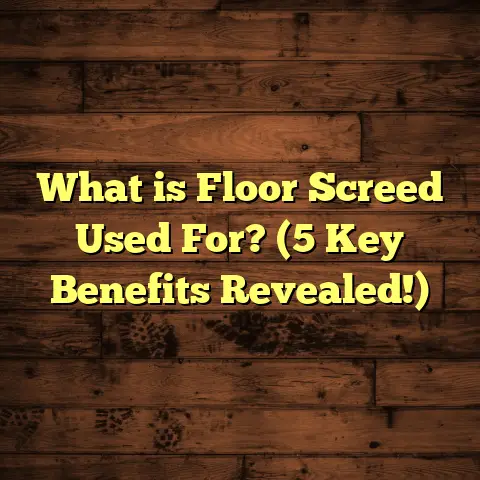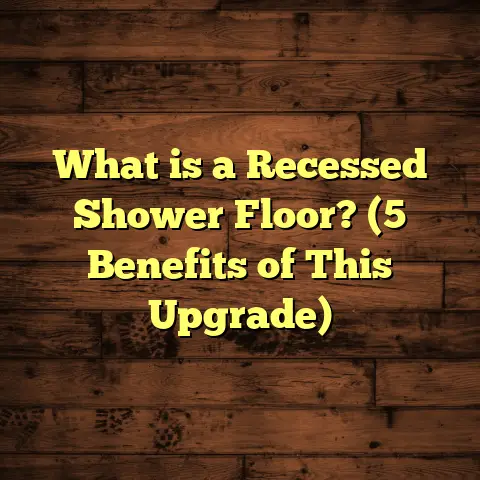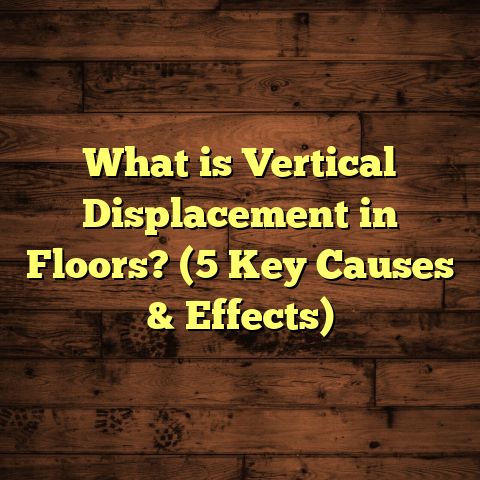What is Cheaper: Carpet or Wood Flooring? (5 Key Cost Factors)
What is Cheaper: Carpet or Wood Flooring? (5 Key Cost Factors)
Durability tends to jump into my mind before anything else when someone asks me about flooring. I mean, what’s the point of picking a floor that looks great today but falls apart in five years? From countless projects and chats with homeowners, I’ve seen durability quietly shape the whole conversation about flooring choices, especially between carpet and wood. If you’re debating which one to pick, you’re probably wondering about cost, but there’s more to it than just the initial price tag.
I want to take you through this from my perspective as a flooring contractor who has installed both carpet and wood in everything from cozy apartments to sprawling family homes. Over the years, I’ve gathered plenty of stories, data, and real-world examples that will help you understand the real costs behind both options—not just upfront but over time.
Understanding the Cost Debate Between Carpet and Wood Flooring
Let’s start by unpacking the core question: what really makes carpet cheaper or more expensive than wood flooring? You might have heard that carpet is “budget-friendly” while hardwood is “luxury,” but that’s only part of the story.
When I talk to clients about this, I always stress that cost isn’t just about the dollars per square foot you see in a showroom or online. There are layers: material quality, installation complexity, maintenance demands, lifespan, and even how each affects your home’s resale value. All these things add up.
Over the years, I’ve seen folks get tripped up by focusing too much on the upfront numbers. For example, someone might choose a cheap carpet to save money now, but three years later they’re frustrated with stains and wear, which means replacing it early. On the flip side, others put down hardwood thinking it’s too expensive and miss out on a floor that lasts decades with proper care.
So let me share with you five key cost factors based on my experience—and some numbers—that will help you figure out what’s really cheaper for your home.
1. Upfront Material Costs: What You Pay Right Away
I remember one client who was shocked when I showed them a solid oak hardwood price list. They expected something around $3 per square foot like carpet but saw prices closer to $10 per square foot. That’s a big sticker shock.
Carpet is usually the least expensive material to buy outright. Basic synthetic carpets can start as low as $2 per square foot. Mid-range carpets—say nylon or polyester blends—go for $4 to $8. Wool or specialty carpet can push higher, sometimes close to hardwood prices.
Wood floors come in a range too. Solid hardwood varies depending on species: domestic oak or maple might be $6-$9 per square foot, while exotic woods like Brazilian cherry or teak can be $12 or more. Engineered wood offers a middle ground—usually $7-$11 per square foot—and still looks like real wood but uses a plywood base for stability.
Here’s a quick comparison table I often use with clients:
| Flooring Type | Average Material Cost per Sq Ft |
|---|---|
| Basic Carpet | $2 – $5 |
| Mid-Range Carpet | $5 – $8 |
| Wool/Specialty Carpet | $8 – $12 |
| Solid Hardwood | $6 – $12 |
| Engineered Hardwood | $7 – $11 |
That said, remember that low-cost carpet often means lower durability. The materials are lighter weight and prone to crushing or staining. So while you might save upfront, you could spend more replacing it sooner than expected.
My take: If budget is tight and you want comfort underfoot, carpet is tempting because of the low initial cost. But don’t just pick the cheapest you find—think about how long you want it to last.
2. Installation Costs: Labor Makes a Big Difference
Installation is where many people get surprised. Carpets are generally faster and easier to install. Professional installers usually charge between $1 and $3 per square foot for carpet installation, depending on factors like room shape and existing floor prep.
Wood floors require more skill and time. Solid hardwood must acclimate to your home’s humidity before installation to prevent cracking or warping later. Installation might also include laying a subfloor, nailing or gluing planks down, sanding, and finishing on site. Because of this complexity, labor rates often run between $4 and $8 per square foot.
One memorable job I had involved a client wanting to DIY carpet installation to save money. It looked simple until they struggled with seams and wrinkles, eventually calling me back for professional repairs. The lesson? Sometimes trying to save on labor can backfire if you end up fixing mistakes.
For engineered hardwood floors, installation can be a bit easier since many come with click-lock systems that float above the subfloor. That can bring labor costs down slightly compared to traditional hardwood.
Pro tip: Always get multiple quotes from installers for both carpet and wood. Some installers specialize in one type and may offer better pricing or guarantees.
3. Maintenance and Upkeep: Ongoing Costs Over Time
One thing I’ve learned firsthand is that maintenance can quietly drain your budget if you’re not prepared.
Carpet requires regular vacuuming—ideally daily in high-traffic areas—and periodic deep cleaning every 12-18 months. If you have pets or kids, plan for more frequent cleanings. Professional steam cleaning costs typically range from $100 to $300 per session depending on home size.
Plus, carpets stain easily and show wear faster in busy spots like entryways or hallways. That means spot treatments or even patch repairs may be needed over time.
Wood floors are different beasts. Daily maintenance involves sweeping or dust mopping to collect dirt that could scratch surfaces. Damp mopping with specially formulated wood floor cleaners keeps them looking fresh without damage.
The good news? Wood doesn’t trap allergens like carpet does, which can improve indoor air quality—a bonus if anyone has asthma or allergies.
Every 7-10 years or so, solid hardwood may require refinishing to restore its original beauty. This involves sanding off scratches and applying new finish coats at about $2-$4 per square foot.
I had one client who switched from carpet to hardwood because their carpet was worn out after seven years despite regular cleaning. They loved how easy the wood was to keep looking new with just occasional refinishing.
Maintenance cost estimate over 10 years:
| Flooring Type | Annual Cleaning Cost | Additional Costs (Repairs/Refinishing) | Total 10-Year Maintenance Cost (Estimate) |
|---|---|---|---|
| Carpet | $150 | $500 (spot repairs/replacement areas) | Around $2,000 |
| Hardwood | $100 | $3,000 (refinishing every 7-10 years) | Around $4,000 |
While wood maintenance looks higher upfront because of refinishing, it also extends the life of your floor dramatically.
4. Lifespan: How Long Will Your Floor Last?
This is where the numbers start telling a different story than just looking at initial costs.
Carpets typically last 5 to 10 years before they need replacing due to flattening fibers, stains that won’t come out, or general wear and tear.
Hardwood floors can last for decades—25 to 50 years or more—with proper care. Solid hardwood floors can be sanded and refinished multiple times during their life span, making them nearly timeless.
I’ve walked into older homes where the original hardwood floors from the 1950s still shone beautifully after several refinishes. Compare that to carpet needing replacements every decade or so—it adds up fast.
Here’s an example breakdown by lifespan:
| Flooring Type | Typical Lifespan |
|---|---|
| Carpet | 5 – 10 years |
| Hardwood | 25 – 50+ years |
If you think about replacing carpet twice within the same time frame that one wood floor lasts, it starts to flip the cost equation.
5. Resale Value and Aesthetic Appeal
If you plan on selling your home someday soon—or even just want it to feel nicer—flooring choice matters more than many realize.
Wood floors are often seen as a premium feature by buyers and appraisers alike. According to the National Association of Realtors (NAR), homes with hardwood floors tend to sell faster and command about a 1-2% higher price than similar homes with carpeted floors.
Carpet in main living areas sometimes turns buyers off—especially if it looks worn or outdated—but it still has its place in bedrooms or basements where softness underfoot matters more than style.
I remember helping a seller who swapped out dated carpet for hardwood before listing their home. We got several offers above asking price within days because buyers loved the look and quality feel of wood floors.
Choosing hardwood isn’t just about money though—it’s also about how your space feels day-to-day. Wood tends to brighten rooms and adds warmth without trapping dust like carpet does.
Real-World Case Study: Comparing Total Cost Over 20 Years
Let me share a case study from one of my recent projects involving a 1,000-square-foot living space.
Scenario A: Carpet Installation
- Material: Mid-range nylon carpet at $4/sq ft = $4,000
- Installation labor: $2/sq ft = $2,000
- Cleaning & maintenance (over 20 years): Deep clean every 18 months = ~$3,000
- Replacements: Twice in 20 years = Material + labor x 2 = ($6,000 x 2) = $12,000
Total estimated cost over 20 years:
$4,000 (material) + $2,000 (install) + $3,000 (cleaning) + $12,000 (replacements) = $21,000
Scenario B: Hardwood Installation
- Material: Mid-range solid oak at $9/sq ft = $9,000
- Installation labor: $6/sq ft = $6,000
- Maintenance & refinishing (2x in 20 years): ~$6,000 total
Total estimated cost over 20 years:
$9,000 + $6,000 + $6,000 = $21,000
What jumps out here? The total costs over two decades are roughly equivalent in this scenario—but with very different experiences and benefits.
With carpet, you have soft underfoot comfort but need multiple replacements and cleaning cycles. Hardwood offers longevity and easy maintenance but hits your wallet hard upfront.
Additional Factors That Affect Cost You Shouldn’t Ignore
Waste Factor
When ordering material—whether carpet or wood—you should add an extra 5% to 10% for waste due to cutting mistakes or future repairs.
For instance:
If your room is exactly 1,000 sq ft, order 1,050–1,100 sq ft of material.
I always advise clients not to skimp here; running short mid-project causes delays and extra trips that add time and money.
Subfloor Condition
Your existing floor base matters too. If it’s uneven or damaged, expect extra prep work before new floors go down.
Carpet can sometimes go over less-than-perfect subfloors better than wood because it’s softer underneath. Wood usually needs smooth stable subfloors for best results—this may add hundreds or thousands depending on what’s needed.
Room Usage
Think about how each room gets used:
- High traffic areas benefit from durable hardwood.
- Bedrooms might be better suited for cozy carpet.
- Kids’ playrooms? Carpet offers cushioning.
- Pets? Hardwood is easier to clean up after accidents.
All these influence long-term value and cost-effectiveness.
My Personal Flooring Journey
When I remodeled my own house about five years ago, I wrestled with this exact question. My living room had old carpet that was stained beyond saving but replacing it seemed pricey if I picked hardwood.
After crunching numbers and chatting with friends who had both types of floors installed recently, I chose engineered hardwood for its balance of cost and durability.
I spent about double what new carpet would have cost upfront but saved myself future cleaning hassles and replacements I was sure would happen otherwise.
Seeing my house now with those floors makes me glad I chose wood—having guests compliment it never gets old!
Actionable Tips You Can Use Now
- Get accurate quotes: Use tools like FloorTally to get local prices for materials and labor so your budget matches reality.
- Think long term: Calculate how many times you’ll likely replace carpet vs maintaining wood over your expected ownership period.
- Include waste factor: Order extra material upfront so you don’t run short mid-project.
- Consider room function: Pick carpet where softness matters most; choose wood for high traffic zones.
- Ask installers detailed questions: Understand what prep work is needed for your subfloor.
- Factor resale value: If selling soon is likely, hardwood may increase appeal.
- DIY cautiously: Carpet installation looks simple but often leads to costly fixes if done poorly.
- Maintenance plan: Budget annual cleaning for carpets; plan refinishing every decade for hardwood.
- Think allergy impact: Wood floors don’t trap allergens like carpets do.
- Test samples at home: Look at materials in your lighting before deciding—colors affect perception of space and warmth.
Wrapping Up My Take on Costs Between Carpet and Wood Flooring
If you want affordable comfort now without worrying too much about longevity—carpet is tempting because of lower upfront costs and cozy feel underfoot.
But if you’re ready for an investment that pays off in durability, ease of maintenance, improved air quality, and resale value—wood flooring often comes out ahead despite higher initial price tags.
From all my projects combined with research data and client feedback over the years:
- Carpet averages lower upfront but higher replacement costs.
- Hardwood materials plus installation cost more initially but last decades.
- Maintenance costs favor wood if refinishing cycles are factored.
- Resale value typically rises more with hardwood flooring.
So which would I pick again? For my own home? Hardwood without hesitation—but only after making sure my budget could handle it upfront.
For renters or those on tight budgets? Carpet might be more practical short term—but plan for replacements down the road.
I hope this breakdown gives you solid ground for your flooring decision! Feel free to ask if you want personalized advice based on your exact space or budget—I’m here to help you avoid costly mistakes I’ve seen too many times in this industry.





